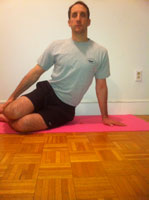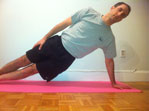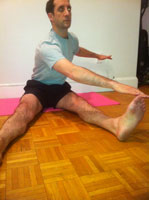Sample Sequence: Pilates for Golfers
Customize moves for clients who need to be clear and free on the fairway.
If you’ve worked with golfers (or those who aspire to play), you know the game is not just for leisure seekers. Golf requires force, flexibility and control. In addition to the sheer physicality involved in carrying a heavy golf bag for 18 holes and leaning over dozens of putts each fairway outing, the actual swing is a delicate balance between freedom of movement and body control. Golfers can find great benefit from working with a Pilates professional who understands not only how the body works but how the right movements address specific needs on the green.
The following sample sequence is designed to tackle the most common strength, control and flexibility limitations found in avid golfers. Since golf is a single-sided physical activity, it’s essential to assess each player’s individual muscular imbalances. Pilates can be exceptionally useful in correcting asymmetries in a golfer’s build. Mental focus can also improve, owing to the concentration required to move through the fluid movements of Pilates while preserving stability.
Golf-Specific Movement
The golf swing includes several phases:
- address: the moments before swing initiation
- backswing: the movement of the club head from initial address to the top of the arc swing
- downswing: the club head’s movement from the top of the arc toward the golf ball
- impact: the moment the club head contacts the golf ball
- follow-through: the movement of the club head past impact
During the initial address, a golfer isometrically contracts the forearms, wrists and hands to grip the club. Core musculature stabilizes the lower-extremity muscles to maintain the position. During the backswing, the rotator cuff muscles stabilize the shoulders and obliques, while the spinal extensors and hip rotators are used to rotate the torso. During the downswing, the rotator cuff, trapezius, core and hip muscles maintain torso stability as the pectoral muscles draw the arms down and the leg muscles transfer weight from back to front, enabling the player to make a powerful, yet controlled impact. The hip and trunk musculature supports the body during follow-through and the rotator cuff decelerates the golf club.
A client who golfs will likely have limited torso flexibility, as well as inadequate rotator cuff and core strength. Incorporating Pilates exercises into a golfer’s conditioning program will promote greater freedom of movement during the swing phase. Pilates will also fine-tune the delicate balance of strength and control that is so essential to a successful golf swing. Pilates, like golf, calls for a stable torso while the extremities fluidly rotate, flex and extend in multiplanar movement.
Sequence for Golfers
| 1. Gluteal Press and Squeeze Goals: to strengthen the core and hips and to open the chest. Begin lying in supine position with palms face-down, 4 inches lateral to hips. Place feet underneath knees, and position Pilates ring between legs just proximal to knees. Inhale, draw bellybutton downward, squeeze Pilates ring, and press hips toward ceiling as you exhale. Pause at top of bridge position, then slowly relax halfway to floor as you inhale. Repeat the squeeze and press 15–20 times. End by gently hugging knees to chest for 30 seconds. |
|
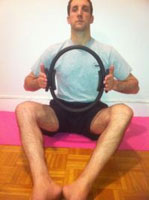 |
2. Shoulder Internal Rotation Goals: to strengthen the shoulder and scapula musculature and to encourage a lengthened posture. Begin seated with legs positioned in soft diamond, soles slightly touching. While holding Pilates ring with both hands in front of chest, inhale, lengthen spine and draw scapulae back. Next, exhale and draw bellybutton toward spine while squeezing Pilates ring. Keep neck relaxed. Be careful not to roll shoulders forward while pressing ring. Perform 12–15 repetitions. |
|
|
3. The Mermaid Goals: to strengthen the obliques and shoulders and to encourage stability. Begin sitting on left hip with knees bent and soles of feet facing behind you. Inhale and place left palm on floor next to left hip, right hand on right side. As you exhale, gently press through left palm and lengthen out of hips to straighten legs and spine, forming straight line from feet to head. Be careful not to allow hips to droop down toward floor or allow shoulders to drop forward or backward. Perform 6–10 repetitions per side. |
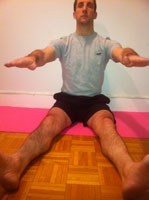
|
4. The Saw Goals: to strengthen the obliques and rectus abdominis and to improve torso flexibility. Begin sitting tall with legs extended slightly wider than hip width. Inhale and extend arms open, parallel to legs, while maintaining lengthened spine and relaxed neck. Exhale, maintaining elongated spine, and lower right arm down toward outer aspect of left pinkie toe with right pinkie finger. Inhale as you engage abdominals to roll back up to starting position. Repeat 6–10 times per side. |
